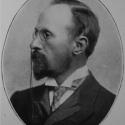
Jeremiah John Bigsby published his travel stories in The Shoe and Canoe, or Pictures of Travel in the Canadas, published in London in 1850. The audio capsule you will hear is inspired from his writing.
00:01 - 01:00
In about 1820, what was a journey to the villages downriver from Quebec like? I’ll be happy to tell you.
I came to the colony as a doctor for the British Army. The War of 1812 was already behind us. As we were at peace, I was sent to inspect the territory along the river below Quebec for ore deposits that might be mined. That was how I became a geologist: by chance!
My first journey eastward took place in the year 1819. Part of the journey between Quebec City and Malbay could be made by carriage. However, several times along the way, one was obliged to descend and walk on paths that were very hard going, by my troth! After exploring the Malbay area, we set sail for the south shore of the river.
We landed in the evening near Sainte-Anne-de-la-Pocatière. After waiting for low tide, we walked to a cottage, where we spent the night. For supper, we were given black bread and bacon, and a decoction of burnt beans called coffee. We slept in the barn, fully clothed.
01:01 - 2:00
On the morrow, our chief awoke in torment, bitten all over by insects and suffering from a stomach upset. Water from a dirty lake is neither wholesome nor palatable after drinking iced champagne every day. It is only for the young to go on a tramp in a country with no inns! So disconcerted was he that, having procured with some difficulty a calash, he started forthwith for Quebec, taking with him my friend Ritchie.
I was now alone, trudging on foot towards the small village of St. Thomas. I must tell you, with the state of the roads at those times, the walking pace of a traveller with no baggage was just little slower than a horse-drawn conveyance.
In 1821, I visited the eastern reaches again. The new steamers make the traveller’s life considerably easier! Among the passengers were officers, merchant families -- English from Montreal, and French from Quebec. Even some Americans were on board. We noticed growing numbers of them touring the two Canadas.
2:01 - 2:33
The stop after Île d’Orléans was Kamouraska. We dropped anchor in a bay before a row of fifty neat-looking houses on a bank a mile long.
The passengers had the choice of crossing over to the other shore, running about until the steamer’s return, or seeking shelter in some boarding house. For myself, I was fortunate in my selection and found some delightful French society with whom to pass the evenings. I remember a lady from Montreal, a skilled musician, who admirably preserved the traditionary manner and costume of Old France.
2:34 - 3:23
Once the steam-boat has gone, you’re on your own! I crossed the river to Malbay, or Murray Bay, in a fishing boat. I was left on the muddy beach with my small baggage at three o’clock in the morning, cramped, cold, and hungry. At dawn, a kindly peasant allowed me to warm myself in his house. At that time, the seigniory of Malbay was a secluded spot, with no services or amusements for the tourist. Its attraction lies in its picturesque landscapes and the untouched wilderness around it.
I would have liked to continue on to Tadoussac, but knowing what a difficult journey awaited me, I turned westward to return to Quebec on foot, sleeping in the homes of habitants at the Eboulements, St. Paul’s Bay, and lastly, Cape Tourment.
I brought back indelible memories from this excursion … along with blisters galore!

